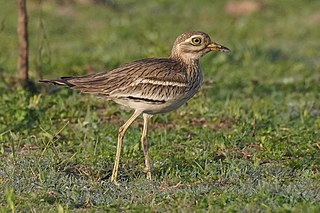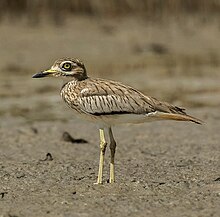
The stone-curlews, also known as dikkops or thick-knees, consist of 10 species within the family Burhinidae, and are found throughout the tropical and temperate parts of the world, with two or more species occurring in some areas of Africa, Asia, and Australia. Despite the group being classified as waders, most species have a preference for arid or semiarid habitats.

The bush stone-curlew or bush thick-knee is a large, ground-dwelling bird endemic to Australia. Its favoured habitat is open plains and woodlands, where it stalks slowly at night in search of invertebrates such as insects. Its grey-brown coloration is distinguished by dark streaks, its eyes are large and legs are long. It is capable of flight, but relies on the camouflage of its plumage to evade detection during the day; the bush curlew adopts a rigid posture when it becomes aware of an observer. Both sexes care for two eggs laid on the bare ground, usually sited near bush in a shaded position or next to a fallen branch.

The Eurasian stone-curlew, Eurasian thick-knee, or simply stone-curlew is a northern species of the Burhinidae (stone-curlew) bird family.

The double-striped thick-knee is a stone-curlew, a group of waders in the family Burhinidae. The vernacular name refers to the prominent joints in the long greenish-grey legs, and bistriatus to the two stripes of the head pattern.

The spotted thick-knee, also known as the spotted dikkop or Cape thick-knee, is a wader in the family Burhinidae. It is native to tropical regions of central and southern Africa.

Burhinus is a genus of birds in the family Burhinidae. This family also contains the genus Esacus. The genus name Burhinus comes from the Greek bous, ox, and rhis, nose.

The Indian stone-curlew or Indian thick-knee is a species of bird in the family Burhinidae. It was formerly included as a subspecies of the Eurasian stone-curlew. This species is found in the plains of South and South-eastern Asia. They have large eyes and are brown with streaks and pale marks making it hard to spot against the background of soils and rocks. Mostly active in the dark, they produce calls similar to the true curlews, giving them their names.











